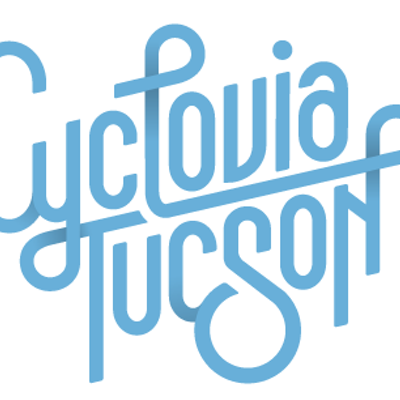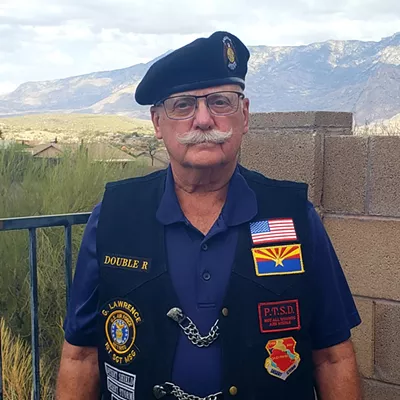These eerie sculptures are called ghost bikes--memorials to people who've been killed while riding bicycles, placed at or near the site of a rider's death. They're sometimes accompanied by plaques that display the victim's name and a reminder to drivers to be aware of cyclists.
According to ghostbikes.org, the movement started several years ago in St. Louis, and has spread around the world. In May, it came to Tucson, when Ari Shapiro, the owner of Xoom Juice, made the first local ghost bike for José Rincon, a 14-year-old boy who was hit and killed in January near Broadway Boulevard and Vozack Lane. (See "'It Doesn't Seem Right,'" April 3.) Shapiro got the idea from an article in New York Magazine about the ghost bike movement in New York City.
"To see a ghost bike placed there, in memory of my son, it's very comforting, very touching," said Adriana Rincon, José's mother.
Rincon said that once she found out that Shapiro made the ghost bike, she introduced herself and thanked him. Rincon is a regular patron of Xoom Juice, though she and Shapiro had never met.
Ghost bikes are not only made to memorialize victims, but also to caution drivers and remind them to share the road, said Shapiro. His then-anonymous contribution caught on, and since May, at least five other ghost bikes have appeared along Tucson city streets.
A small, loosely organized group of people put up the other ghost bikes, with the help of Bicycle Inter-Community Action and Salvage, or BICAS, a nonprofit organization that donated bicycles to the cause.
Attorney Erik Ryberg used police reports to find ghost bike candidates and locate their accident sites. Ryberg worked with other bicycle enthusiasts Janet Miller, Paulus Musters and Dan Fleury to degrease, strip and spray-paint the salvaged bicycles. Miller, a local artist, did all the assembly and welding, said Ryberg.
Not only do the ghost bikes take some effort to make; keeping them where they belong has been a challenge.
The city of Tucson Department of Transportation asked Shapiro to move the Rincon ghost bike, because it was chained to a city street sign. But when Shapiro went to remove the bicycle in mid-July, it was already gone. Mike Graham, a spokesperson for the department, said that while memorials can't be attached to signs or block visibility or access, his department did not remove the ghost bike. The Tucson Police Department has no record of a theft report for the memorial.
Since then, a new ghost bike has appeared for Rincon. Both Shapiro and Rincon said they don't know who made the new ghost bike.
Rincon said she is especially touched that not just one, but two strangers were moved to create these memorials for her son. The second Rincon ghost bike is not chained to city property, she added, so there is less chance it will be removed.
Since the city doesn't allow anything to be attached to signs, ghost bike makers had to find a new way to keep the memorials at their sites. Now, the rear wheel of each ghost bike is sunken into a concrete block, which is buried. That way, the memorials are difficult to remove and don't interfere with city property.
However, not everyone is thrilled about having a ghost bike on their property. Ryberg was asked by a property owner to remove the ghost bike remembering Andria Ligas, a UA student who was killed in December 2002. The memorial was on the east side of Euclid Street, between Adams Street and Lee Street.
On his blog, Tucsonbikelawyer.com, Ryberg said of the property owner, "Evidently, he felt it was an eyesore that he should not have to endure in front of his property."
Ryberg took the ghost bike down July 27, and said there is no other logical place to put it.
"We don't really know what to do now," said Ryberg, whose office now houses the Ligas bicycle.
He and his assistant Lauren Frisk, who also works at Ordinary Bike Shop, 311 E. Seventh St., have attempted to get police reports for all Tucson cycling fatalities in the past 10 years.
While they've obtained some of the records, said Ryberg, "What we got was very incomplete, and it was kind of disappointing. We were both able to name people who have died in the city limits whose police reports didn't show up as a result of that request."
The reason for obtaining the records, said Frisk, is not just to get information for the memorials.
"Erik is trying to monitor ... year to year the number of people who are dying on bikes (and) what happens to the person who is found guilty of killing a bicyclist. ... (He) also wants to make this available for potentially putting up more ghost bikes," said Frisk.
"We feel that it's important that these people don't die in vain and that justice is served," Frisk added. "Just because they're on a bike doesn't mean they should be treated any differently."
When asked if he had more plans to contribute to the ghost bike movement, Ryberg said: "We don't exactly have any plans, but it wouldn't surprise me if we did so. I know we want to keep putting up ghost bikes."








